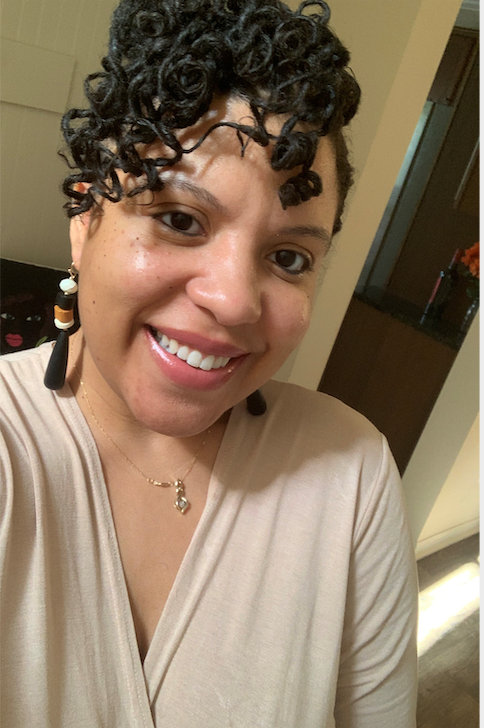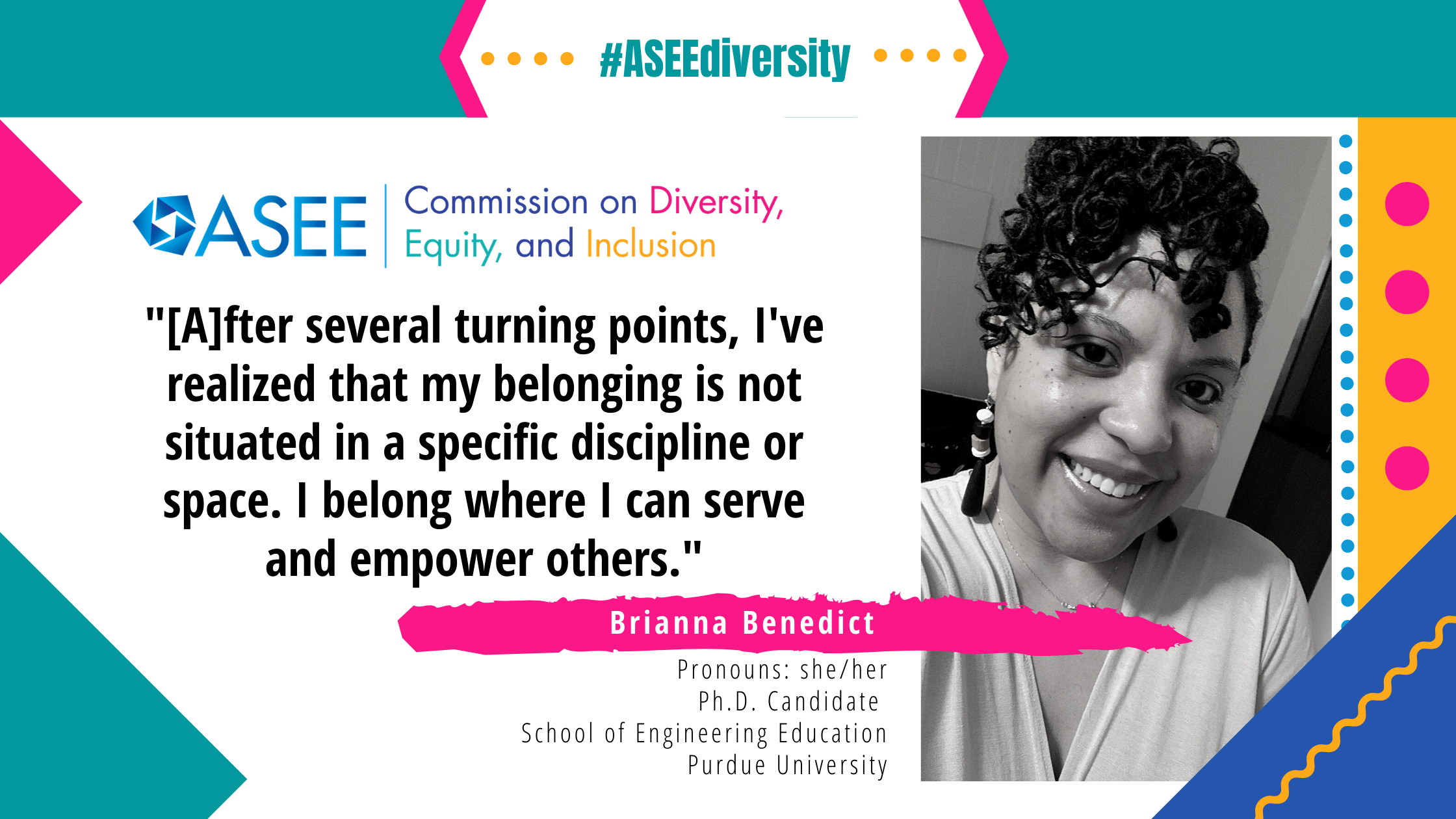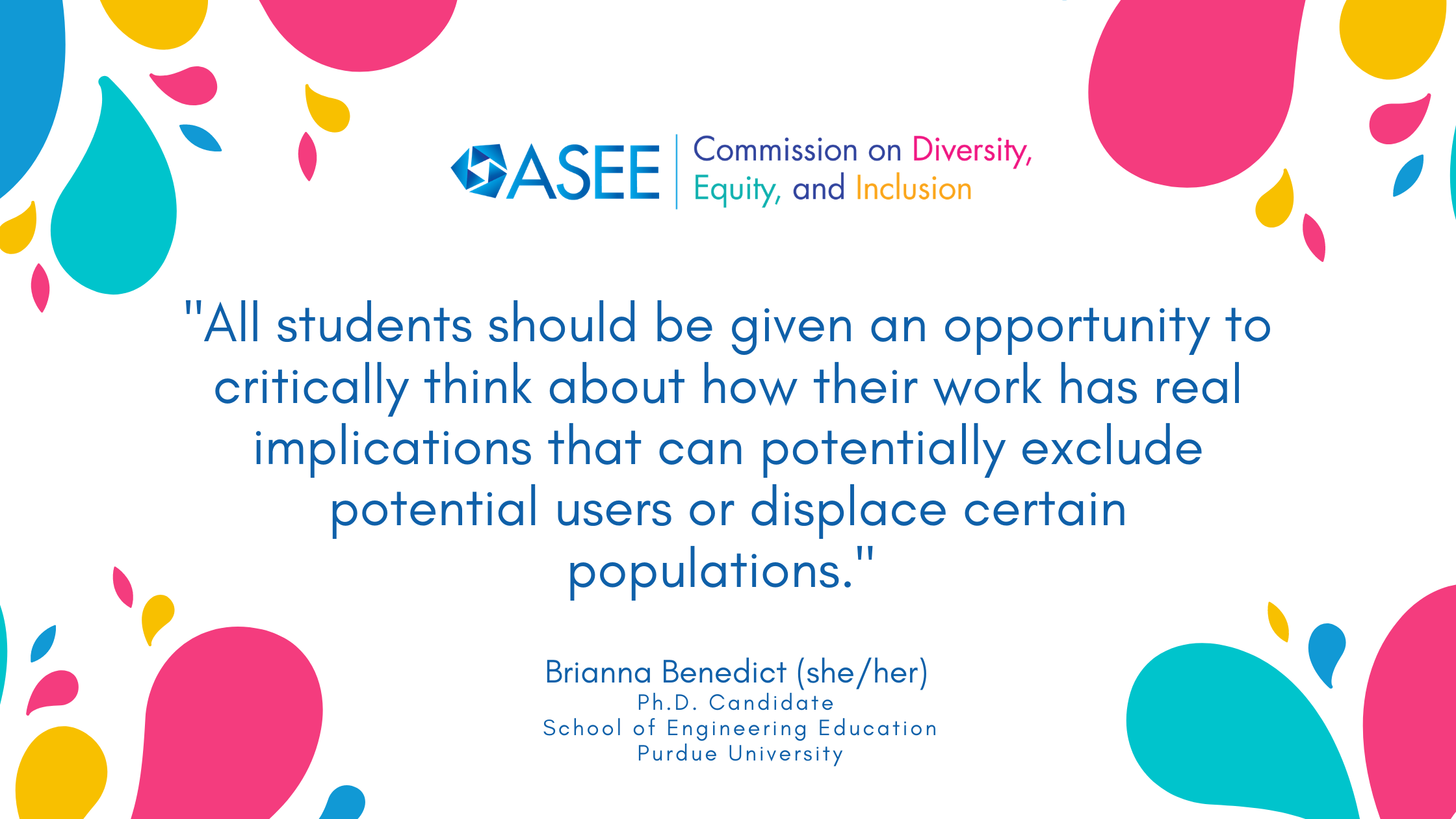
ASEE CDEI Scholar Spotlight Series: Brianna Benedict
Brianna Benedict: Building a community of educators passionate about diversity, equity, and inclusion in engineering education.
In this blog post, we have the honor to hear the story of Brianna Benedict (She/Her), our first graduate student to be featured in this blog series. For the past years, Brianna Benedict has been a Ph.D. Candidate in the School of Engineering Education at Purdue University. She earned her Bachelor’s and Master’s of Science in Industrial and Systems Engineering from North Carolina Agricultural and Technical State University. Her current research focuses on understanding how hybrid spaces influence engineering students’ identity development, belonging, and agency in interdisciplinary engineering education.
She is also an all-star ASEE volunteer by leading the ASEE CDEI virtual workshop team focused on building a community of educators passionate about expanding their knowledge concerning diversity, equity, and inclusion in engineering education. Evidence that all graduate students are welcome to get highly involved in our professional organization by volunteering. Her most recent accomplishment was being recognized as one of seven Association of American Colleges & Universities 2019 K. Patricia Cross Scholars based on her commitment to teaching and learning and civic engagement. I am sure that her story in this interview will resonate with many of you. Enjoy!
At the end of this post, don’t miss out on the opportunity to connect with our scholar and learn more about the ASEE CDEI‘s efforts.
ASEE CDEI Communications Committee Volunteers:
- Introduction, editor and webmaster: Sindia M. Rivera-Jiménez, Ph.D., University of Florida (Twitter)
- Editors: Susan Boerchers, Lafayette College; Tershia Pinder-Grover, University of Michigan, Homero Murzi (Twitter), Virginia Tech, and Elizabeth Litzler, University of Washington.
Scholar Interview
Q1: Can you tell us your story of belongingness?
As someone who often asks students about their belonging in engineering, I must admit this question is tough to answer. I’ve literally rewritten this sentence several times because I wasn’t quite sure where to start or end. My story of belonging didn’t quite begin when I started my journey as an engineering student at North Carolina Agricultural and Technical State University (AGGIE PRIDE!!!). However, this institution shaped my personal and professional life because it is where I learned that I did not have to compartmentalize my passion for community service, education, and engineering.
Unlike some of the students who participated in my research studies, I did not aspire to pursue a career in engineering from a young age. I stumbled across engineering because I realized that the medical field wasn’t for me while working on my high school senior project. Through an experience where I designed a project motivated by my personal experiences, I shadowed an oncology nurse to understand more about the top three cancers impacting women’s lives. In this process, I developed prototypes of the multiple stages of breast cancer and the portacath used to deliver chemo. I learned a great deal about an oncology clinic’s operations; however, after careful evaluation, I realized that I did not want to pursue a nursing career. Instead, I decided to speak with a family friend who was also a high school math teacher. During this conversation, she told me about Industrial and Systems Engineering and how her son enjoyed his experience studying electrical engineering at North Carolina Agricultural & Technical State University. This conversation prompted me to explore the broad range of engineering disciplines and ultimately pursue a career in industrial and systems engineering. However, after several turning points, I’ve realized that my belonging is not situated in a specific discipline or space. I belong where I can serve and empower others.

Brianna Benedict (she/her ) / Ph.D.Candidate School of Engineering Education Purdue University
Q2: What is your understanding of Diversity, Equity, and Inclusion (DEI), and why is it important to what you do?
Within the past few years, there has been a rise in organizations intentionally defining their mission and commitment to diversity and inclusion. Historically, these efforts have fallen short by only focusing on recruiting “diverse candidates” without their organizations examining the climate and refining the culture to support these candidates once recruited. Some organizations have led efforts to build a culture where everyone can establish a sense of belonging and create roles where specific professionals are dedicated to mitigating diversity and inclusion issues. However, challenges persist because, in many ways, diversity, equity, and inclusion are often treated as buzz words and fail to mitigate the critical incidents that occur at micro levels and ignore systemic issues that have significant impacts.
For example, in the past year, there has been increased attention to the existence of racism in society and engineering education. Yet, in my world, this is not a new issue. Although my research interests are not directly tied to race or gender, as a Black woman in STEM [education], I have experienced microaggressions albeit related to my race, gender, or both, where, in some instances, I questioned whether I belonged. However, instead of allowing these experiences to defeat me, I decided to show up and, more importantly, empower others who also may have similar experiences. Consequently, I wholeheartedly hold value in creating a culture where my colleagues and students feel empowered to contribute without negotiating who they are to establish a sense of belonging. I believe engineering education should recognize diversity, equity, and inclusion as central to its purpose and mission rather than additional considerations. Students need to grapple with how systems of oppression manifest in engineering teams and translate to their solutions. By centering on diversity, equity, and inclusion, engineering education can begin to address ways to create inclusive classrooms and research designed for all rather than just a few..
Q3: What are your current initiatives towards DEI work?
In the past, I’ve served as the social justice, and inclusion chair for Engineering Education Graduate Student Association (ENEGSA), a collaborator in an anti-racism steering committee, and participated in several panels aimed to increase the representation of minoritized students in engineering.
Currently, I lead the national ASEE Commission on Diversity, Equity, and Inclusion (CDEI) Virtual Workshop team. My primary role is to invite community members to facilitate interactive workshops focused on diversity, equity, and inclusion and manage the review process for each submission. We use this platform to invite researchers and practitioners from various fields to share their knowledge about diversity and inclusion in education. Throughout this role, I have facilitated conversations focused on allyship and co-moderated a summer session focused on the joint statement released by the American Society for Engineering Education (ASEE) and the European Society for Engineering Education (SEFI). This joint statement was designed as a call and pledge for action to increase diversity and inclusion in engineering. I also challenged participants to reflect on how the engineering education community can intentionally use the statement in their immediate sphere of influence (i.e., classroom, research lab, or department). In addition to hosting workshops focused on diversity, equity, and inclusion, it is equally essential to ensure the virtual workshop experience is accessible to our participants and establish community guidelines. These practices create a virtual environment where participants are motivated to share their perspectives and feel comfortable engaging in difficult conversations.
Q4: What do you see as the next steps for your DEI work?
At the forefront of my vision, I want to build on and design learning experiences where students will be challenged to think about how and why diversity, equity, and inclusion matter in and beyond the engineering profession. Some of our students will join the medical field, law, business, and other professions to confront problems that involve knowledge and skills not currently prioritized in engineering. All students should be given an opportunity to critically think about how their work has real implications that can potentially exclude potential users or displace certain populations.
Also, as the leader of the CDEI virtual workshop team, I am interested in forming strategic partnerships with scholars and practitioners within the other ASEE divisions. We are grateful for the engagement within the CDEI community. However, I see this partnership as an opportunity to invite members from other ASEE divisions to host workshops and discussions about diversity, equity, and inclusion in their fields. This goal aligns with what I stated earlier about removing silos between diversity, equity, and inclusion, and engineering, due to a recent experience where some reviewers believe “diversity papers” belong in certain divisions such as Minorities in Engineering Division (MIND) or Women in Engineering Division (WIED). Again, I believe we need to dismantle silos within ASEE divisions and that conversations about diversity, equity, and inclusion should be embedded and valued in every division because it is everyone’s responsibility, not just the few who naturally gravitate to these spaces.
In addition, my long-term research goal focuses on understanding how to create inclusive engineering environments that support diverse perspectives and identities to promote interdisciplinary outcomes and broaden engineering solutions. I plan to build towards my long-term goal with multiple short-term goals. One of my research goals involves examining what aspects of interdisciplinary programs support women and other minoritized students in engineering. Prior research suggests interdisciplinary programs increase participation among women in engineering. However, a need exists to understand how interdisciplinary engineering programs provide pathways to broaden participation in engineering. As a result, I plan to build on my dissertation research by exploring the role of interdisciplinary programs’ in broadening participation among various social identities across multiple interdisciplinary engineering programs.
Q5: What recommendations do you have for engineering educators to start incorporating social justice in their classrooms?
- Before engineering educators begin incorporating these topics into their classroom, they must grapple with their own biases and how their beliefs inform their actions in the classroom and interactions with their colleagues.
- Reflect on your positionality and how it informs your research and teaching
Be consistent by ensuring your practices are reflected in your professional (e.g., research, teaching, and service) and personal life. - I think it’s important to be conscious of how you position students and who and what you endorse in your classroom through course materials.
- Increasing the representation of minoritized students in engineering is a start. However, engineering educators need to make sure that we are creating learning environments that truly embody that multiple perspectives are valued in engineering.
- Pay attention to your students and be mindful of your interactions that communicate messages of what counts and who belongs in engineering.
- Invite guest instructors to be a bridge by supporting your students’ growth by providing alternative perspectives, career pathways, and networks.
Q6: What resource can you recommend to people who want to learn more about DEI in your field?
Currently, I’m reading a book authored by Dr. Ebony McGee, “Black, Brown, and Bruised: How Racialized STEM Education Stifles Innovation,” but I’ve also listed a few other resources that may be helpful.
- Visit our website to access the previously recorded workshops on a variety of topics and stay tuned for our upcoming workshops in 2021- View. If you’re interested in facilitating a virtual workshop, feel free to submit a proposal or contact me via email (benedicb@purdue.edu).
- Engineering change podcast with Dr. Yvette Pearson- View
- Read guest editorials published in the Studies in Engineering Education and Journal of Engineering Education
- Reach beyond the resources provided by your institution by attending virtual seminars hosted by institutions that have open registration (e.g., University of Michigan and Ohio State University).

Ph.D. student, Brianna Benedict (2nd from left) and undergraduate researcher, Rachel Baker (4th from left) recognized for ASEE Best Diversity Paper Finalist paper asking about “what counts” and “who belongs” in engineering culture at ASEE Annual 2018
Recommended ASEE PEER paper from our scholar:
Benedict, B. S., & Verdín, D., & Baker, R. A., & Godwin, A., & Milton, T. (2018, June), Uncovering Latent Diversity: Steps Towards Understanding ‘What Counts’ and ‘Who Belongs’ in Engineering Culture Paper presented at 2018 ASEE Annual Conference & Exposition , Salt Lake City, Utah. 10.18260/1-2–31164
Abstract Excerpt: “In this paper, we examined how 12 diverse first-year engineering students described how their peers enact different ways of thinking and being in engineering, as well as how those differences influence whether their peers are perceived as someone who belongs in engineering. The participants acknowledged the cultural and gender differences among their peers; however, they primarily described how their peers were different based on their skill-set (i.e., technical, creative, and interpersonal), ways of thinking, and interests. These findings begin to help us understand how students define normative attitudes in engineering and the perception of what it means to be an engineer.”
Find more articles on ASEE Peer for this scholar: Brianna Benedict
Connect with our scholar:
Getting involved with CDEI
- If you want to recommend someone for our Spotlight series click here.
- Check out website Highlights:
- Resources
- Past Blogs and Events
- Compilation of Newsletters and Reports
- Connect with the committee:
- Become a Friend of the Committee
- Follow us and tag us on Twitter
- Become a volunteer on our Communications Committee! We are always looking for people that want to share or improve their writing and leadership skills.
Check out other Spotlight Scholars:
- Dr. Homero Murzi: Creating culturally responsive environments by focusing on the voices of our engineering students (September, 2020)
- Dr. Tony E. Butterfield: Empowering faculty and students to create an inclusive environment for the LGBTQ+ community (October, 2020)
- Dr. Carlotta A. Berry: From trailblazer to building a strong community and network to foster allyship and confidence among engineering students (February, 2021)
- Dr. Lindsay Soh: From actively maintaining a sense of belongingness to helping others develop their own (March, 2021)
- Dr. Idalis Villanueva-Alarcón: Using her experiences in liminality served as a lens for research scholarship that challenges normative ways of learning. (April 2021)


